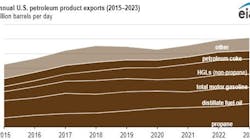Sam Fletcher
OGJ Senior Writer
HOUSTON, May 31 -- Energy prices reversed again at the end of last week with the front-month crude contract regaining on May 27 a little of its loss from the previous session in the New York market.
“The broader markets and oil both rose slightly on a weaker dollar in light of volumes as investors stole away to enjoy the Memorial Day weekend,” said analysts in the Houston office of Raymond James & Associates Inc. Moreover, they said, “Forecasts for a hot July and pre-holiday weekend short-covering helped natural gas surge over 3%.”
Raymond James analysts pointed out, “For several weeks now, the weekly natural gas storage numbers have indicated a tightening supply-demand balance in the natural gas market, and prices have responded in kind.” Most of that tightening, they said, “can be explained by increased nuclear outages and a subsequent boost in natural gas demand.” They said, “We believe that nuclear outages are driving 3 bcfd of year-over-year tightening in the gas market, and that this is set to unwind over the coming weeks as nuclear capacity returns.”
On May 30, however, Germany announced it will close all 17 of its nuclear reactors within the next decade in a complete reversal of energy policy—the first major economy to abandon nuclear power following the crisis of damaged reactors in Japan. Loss of Germany’s nuclear power will increase its demand for gas in the near term, “primarily Russian gas,” said Raymond James analysts. “Over the next 5-10 years, offshore wind should also offset part of the lost nuclear generation, though this will require substantial grid development around the North Sea. Solar should also see some benefit, though it is a source of peaking power; therefore solar capacity does not compensate for baseload nuclear capacity on anything close to a 1:1 basis.”
Analysts said clean coal (with carbon capture and sequestration) could be part of the solution once it becomes commercialized.
The phase-out must be approved by parliament. The 17 reactors provide total power of 20.3 Gw, the world's fifth highest from nuclear plants, and provide 23% of Germany's electricity. Raymond James analysts said 8 older reactors already off line for safety reviews will not restart. Another 6 units will be mothballed by 2021 at the latest and the final 3 reactors by 2022.
“Germany would then become the largest industrialized country without nuclear power (Italy is the only other one in the G8),” Raymond James reported.
In other news, TransCanada on May 30 temporarily shut down the Keystone Pipeline because of “a minor spill” at a pump station in Kansas. The pipeline delivers 500,000 b/d of oil to the US from Alberta. It supplies the Cushing, Okla., delivery point for benchmark US crude. A long disruption could push prices higher, but TransCanada officials said they hope to have the line back in service “within a few days.”
World demand
Adam Sieminski, chief energy economist, Deutsche Bank AG, Washington, DC, noted oil market price corrections for May “in the most recent reports” from the International Energy Agency (IEA), the Organization of Petroleum Exporting Countries, and the Energy Information Administration (EIA) under the US Department of Energy.
“The IEA cited lower oil demand growth forecasts, while OPEC complained about ‘excessive speculative activities,’” Sieminski said. “World gross domestic product growth forecasts for 2011 are slipping toward 4% after very strong 4.8% growth in 2010. Risk perceptions are therefore shifting to the downside.”
As a result, he said, “Forecasts for 2011 world oil demand growth are being trimmed for the first time. IEA notes persistent high prices and weaker GDP in its 1.3 million b/d estimate (up 1.5%). Non-OPEC supply estimates are pointing toward 700,000 b/d growth in 2011. EIA's forecast for 2012 of 400,000 b/d suggests slower supply growth ahead. OPEC natural gas liquids production of about 600,000 b/d in 2011 contributes to overall supplies that fall outside of OPEC quotas.”
Energy prices
The July contract for benchmark US light, sweet crudes regained 36¢ to $100.59/bbl May 27 on the New York Mercantile Exchange, which was closed May 30 for the Memorial Day holiday in the US. The August contract advanced 34¢ to $101.16/bbl. On the US spot market, West Texas Intermediate at Cushing was up 36¢, also to $100.59/bbl.
Heating oil for June delivery inched up 0.76¢ to $2.99/gal on NYMEX. Reformulated blend stock for oxygenate blending for the same month escalated by 4.37¢ to $3.09/gal.
The July natural gas contract jumped by 15.8¢ to $4.52/MMbtu on NYMEX. On the US spot market, gas at Henry Hub, La., was up 9.5¢ to $4.4/MMbtu.
In London, the July IPE contract for North Sea Brent crude dipped 2¢ to $115.03/bbl. Gas oil for June was down $2 to $939.75/tonne.
The average price for OPEC’s basket of 12 reference crudes on May 30 dropped 68¢ to $109.59/bbl.
Contact Sam Fletcher at [email protected].

